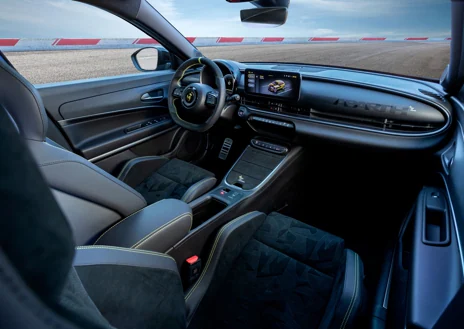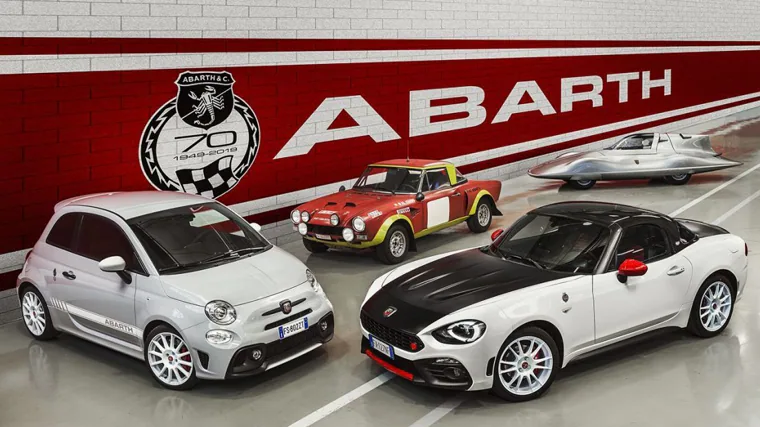75 years have passed since Carlo Abarth, intrepid driver and engineer by vocation, tightened the first screw of what is today the sporting banner of the FCA group.
Known in its origins for its numerous records – Carlo Abarth himself broke the quarter mile in 1965 aboard his Abarth 1000 monoposto in 1965, after losing 30 kilos by eating only apples just to be able to get in -, it has recorded growth of Sustained sales since its relaunch as an independent brand in 2008.
On its 75th anniversary, Abarth makes a special gift to its community and reveals three unpublished images of the New Abarth 600e Scorpionissima: the most powerful Abarth in history, equipped with 240 HP, mechanical limited slip differential and competition content.
Attractive is the perfect definition for the interiors of the New Abarth 600e Scorpionissima: the dashboard enriched with Abarth graphics, the exclusive pattern and a dark atmosphere are some of the characteristics of the mysterious cabin embellished with details such as the menacing Scorpion on the steering wheel or the stitching of color.
The racing soul of the Abarth 600e Scorpionissima is expressed through specific racing-inspired seats and a sports steering wheel with leather and Alcantara inserts, which enhance the freshness and sportiness of the car. The interior design also features a tunnel cushion cover for extra cabin storage, ambient lighting to emphasize the enigmatic interiors and a 10-inch NAV radio to maximize life-on-board entertainment.
Details of the abarth 600 e
FP

-U60704352015LOX-278x329@diario_abc.jpg)
The infotainment system with Abarth-specific graphics offers the driver performance measurement pages and a dedicated section to easily activate and deactivate the unmistakable Abarth sound provided by the Sound Generator: these features give uniqueness to this aggressive vehicle in terms of connectivity and driving pleasure.
The history
Carlo Abarth (1908-1979) founded Abarth & C. on March 31, 1949, establishing a true legend of style and performance expressed through cars.
The legend of the brand with the Scorpion emblem began on March 31, 1949 when Carlo Abarth (1908-1979) founded Abarth & C. together with the pilot Guido Scagliarini. His first car was the 204 A derived from the Fiat 1100. He attracted attention on April 10, 1950 when Tazio Nuvolari won his last race, the Palermo-Monte Pellegrino. Since then, Abarth's history has been full of racing and industrial records, always with the spirit of the founder combining maximum performance, careful craftsmanship and constant technical improvement.
Carlo Abarth's career began with motorcycles, not cars. At the age of twenty, he racked up his first racing victories on a Motor Thun and the following year he built his first custom motorcycle under the Abarth brand. Unfortunately, during a race in Linz, an accident forced him to abandon the bikes. He continued to compete in a sidecar, a vehicle he made famous due to his great feats, such as the race against the Orient Express train, which he of course won. A second serious accident in 1939 forced him to abandon racing completely.

Models manufactured in the 75 years of Abarth
FP
This marked a new beginning for Carlo Abarth. In 1945, he moved to Merano and became a full-fledged Italian citizen. Then, after a brief experience at Cisitalia, he founded Abarth & C. in 1949 and had the intuition to complement racing activities with the production of his famous transformation kits for mass production vehicles, increasing their power, speed and acceleration. The highlights of the kit were the exhaust pipes which, over the years, have become a true icon of the “Abarth style”. In the space of a few years, Abarth & C. went global. In 1962 it produced 257,000 exhaust pipes, 65% of which were destined for export markets.
Its peak came in the late 1950s and 1960s. With a Fiat Abarth 750 designed by Bertone in 1956, the brand broke the record for endurance and speed. On June 18, at the Monza circuit, he broke the 24-hour record, covering 3,743 km at an average speed of 155 km/h. Then, from June 27 to 29 on the same circuit, he accumulated several records: the 5,000 and 10,000 km, the 5,000 miles and also the 48 and 72 hours. The same vehicle was designed by Zagato in two different versions: the Fiat Abarth 750 Zagato (1956) and the Fiat Abarth 750 GT Zagato (1956). The fame of the automobile reached the ears of Franklin Delano Roosevelt Jr., son of the president of the United States, who immediately left for Italy to personally sign an exclusivity contract with Abarth for the distribution of these vehicles.
In 1958, Abarth completed a true work of art with the new Fiat 500, completely transforming the small utility vehicle and improving its potential to the maximum. That same year, the brand intensified its collaboration with Fiat, as Fiat promised to award cash prizes to Abarth depending on the number of victories and records that the team managed to obtain.
Which laid the foundation for the impressive winning streak that was to come: 10 world records, 133 international records, more than 10,000 circuit victories. The legend continued to grow bigger and bigger, becoming a household name. The sixties were the golden decade for Abarth. “Abarth” became synonymous with speed, value, performance and development. And the list of vehicles that etched the Abarth name in motorsport history is long: from the 850 TC, which was victorious on all international circuits, including the Nürburgring, to the Fiat Abarth 1000 Berlina and the 2300 S that won a series extraordinary record-breaking performance at the Monza circuit despite the harsh weather conditions.
In 1971, Abarth became the sole property of the Fiat Group and the legend continued with the Fiat 124 Abarth, winner of the European title in 1972 and 1975, the 131 Abarth world rally champion in 1977, 1978 and 1980, and the Ritmo Abarth. . Unfortunately, Carlo Abarth died on October 24, 1979, under the sign of the Scorpion, as at his birth, which inspired the emblem displayed on his vehicles.
#Abarth #shows #unpublished #images #600e #Scorpionissima #powerful #history